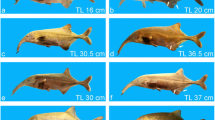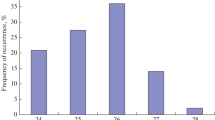Summary
Studies of the hypothalamo-gonadal response of the zebra finch (Poephila guttata castanotis) to environmental factors were conducted by the use of adult birds captured in arid regions of South Australia. In these birds breeding activity is not photoperiodically induced but follows rainfall. The hypothalamo-hypophysial system participating in this response involves centres of the rostral and mediobasal (tuberal) hypothalamus. Parvocellular neurones in both hypothalamic portions are arranged in clusters. In the rostral hypothalamus magnocellular neurosecretory perikarya are spatially closely associated with the clusters which contain different types of parvocellular peptidergic neurones. Extended, complex neuropile formations, rich in synapses, encompass the neuronal clusters and provide important loci of neural-neuroendocrine interaction.
Experiments were undertaken to correlate indicators of breeding activity, such as increased size and mass of testes, spermatogenesis, and plasma levels of androgens and luteinizing hormone, with a greater availability of drinking water, increased air humidity, and green vegetation, all of which follow rainfall. Birds maintained in male/female pairs in controlled-environment rooms at 27° C on 14L10D received a diet of seeds (containing ∼ 10% water). Thirty-two birds were given drinking water at a basal level of 1 ml/week and one of eight different treatments, consisting of different combinations of drinking water, relative air humidity, and green grass, for two weeks (4 males/treatment). The size of the left testis was estimated at laparotomy and blood samples were taken from a wing vein before and after treatment. The observations suggest that, in moisture-deprived (1 ml water/week) adult zebra finches, an increase in testicular size is associated with a free supply of water; synergistic effects of supplying both water and green grass, or water and high humidity, were also observed. However, in six other groups (8–16 males/treatment), receiving a higher basal level of water (access for 3 min/day), an increase in testicular mass was associated with high humidity, while smaller non-significant increases followed the provision of free water or green grass. Spermatogenic activity was not significantly correlated with testicular size or mass. Leydig cells were sparse in all groups. Plasma androgen levels and luteinizing hormone levels were not obviously correlated with the treatments and were lower than values in zebra finches breeding in outdoor aviaries.
Similar content being viewed by others
References
Abraham GE (1969) Solid phase radioimmunoassay of estradiol-17β. Clin Endocr Metab 29:866
Baylé JD (1980) Photoreception and the neuroendocrine mechanisms involved in the photosexual reflex in birds. In: Acta XVII Congressus Internationalis Ornithologici (ed. R. Nöhring). Verl Dtsch Ornithol Ges, Berlin, pp 233–238
Blähser S, Fellmann D (1984) Topographie der Vasotocin-und Corticoliberin-immunreaktiven Systeme im ZNS von Amphibien, Reptilien und Vögeln. Verh Anat Ges 79 (in press)
Blanchard BD (1941) The white crowned sparrow (Zonotrichia leucophrys) of the Pacific seaboard: Environment and annual cycle. Univ Calif Publ Zool 46/1
Bolton B L (1976) Zebra finch breeding records, Arid Zone Research Institute, Alice Springs. (Personal communication)
Brimble MJ, Dyball REJ (1976) Contrasting pattern changes in the firing of vasopressin and oxytocin secreting neurones during osmotic stimulation. J Physiol 263:pp189–190 P
Commonwealth Bureau of Meteorology (1978) Daily temperature, dew point, relative air humidity, and rainfall charts for Alice Springs (1941–1973) and South Australia (1857–1976)
Cross BA (1973) Unit responses in the hypothalamus. In: Aspects of Neuroendocrinology (eds. W. Bargmann, B Scharrer), pp 229–231. Berlin-Heidelberg-New York: Springer Verlag
Davies DT, Follett BK (1975) The neuroendocrine control of gonadotrophin release in the Japanese quail. I. The role of the tuberal hypothalamus. II. The role of the anterior hypothalamus. Proc Roy Soc (Lond.) B 191:285–301, 303–315
Davies SJJF (1977) The timing of breeding by the Zebra Finch Taeniopygia castanotis at Mileura, Western Australia. The Ibis 119:369–372
Emmers R (1973) Interaction of neural systems which control body water. Brain Res 49:323–347
Farner DS, Serventy DL (1960) The timing of reproduction in birds in the arid regions of Australia. Anat Rec 137:354
Follett BK, Farner DS, Mattocks PW (1975) Luteinizing hormone in the plasma of White-crowned Sparrows, Zonotrichia leucophrys gambelli, during artificial photostimulation. Gen Comp Endocr 26:126–134
Frith HJ, Tilt RA (1959) Breeding of the Zebra Finch in the Murrumbidgee irrigation area, New South Wales. The Emu 59:289–295
Gonzălez CB, Rodríguez EM (1980) Ultrastructure and immunocytochemistry of neurons in supraoptic and paraventricular nuclei of the lizard Liolaemus cyanogaster. Evidence for the intracisternal location of the precursor of neurophysin. Cell Tissue Res 207:463–477
Goossens N, Blähser S, Oksche A, Vandesande F, Dierickx K (1977) Immunocytochemical investigation of the hypothalamoneurohypophysial system in birds. Cell Tiss Res 184:1–13
Halász B, Pupp L (1965) Hormone secretion of the anterior pituitary gland after physical interruption of all nervous pathways to the hypophysiotrophic area. Endocrinol 77:553–562
Hoffman JH, Abel JH Jr, McNeill TH (1977) Adrenergic control of hypothalamic function during osmotic stress in the mallard duck (Anas platyrhynchos). Cell Tiss Res 182:177–191
Immelmann K (1962) Beiträge zu einer vergleichenden Biologie australischer Prachtfinken. Zool Jb Syst 90:1–196
Immelmann K (1965) Versuch einer ökologischen Verbreitungs analyse beim australischen Zebrafinken, Taeniopygia guttata castanotis (Gould). J Ornith 106:415–430
Józsa R, Vigh S, Schally AV, Mess B (1984) Localization of corticotropin-releasing factor-containing neurons in the brain of the domestic fowl. An immunohistochemical study. Cell Tissue Res 236:245–248
Kikkawa J (1980) Seasonality of nesting by Zebra Finches at Armidale, N.S.W. The Emu 80:13–20
Mikami S-I, Homma K, Wada M, eds (1983) Avian endocrinology. Environmental and ecological perspectives. Japan Scientific Societies Press, Tokyo/Springer-Verlag, Berlin Heidelberg New York
Mikami S-I, Kawamura K, Oksche A, Farner DS (1976) The fine structure of the hypothalamic secretory neurones of the Whitecrowned Sparrow, Zonotrichia leucophrys gambelii (Passeriformes: Fringillidae). II Magnocellular and parvocellular nuclei of the rostral hypothalamus. Cell Tissue Res 165:415–434
Moss RL, Beechey P (1972) A single current monitoring system for the electrophoretic application of drugs on neurons. Electroeneceph clin Neurophysiol 32:87–89
Oehmke H-J (1971) Vergleichende neurohistologische Studien am Nucleus infundibularis einiger australischer Vögel. Z Zellforsch 122:122–138
Oksche A (1980) Structural organization of avian neuroendocrine systems. In: Biological rhythms in birds. Neural and endocrine aspects (Tanabe Y, Tanaka K, Ookawa I, eds). Japan Scientific Societies Press, Tokyo/Springer-Verlag, Berlin Heidelberg New York, pp 3–15
Oksche A, Farner DS (1974) Neurohistological studies of the hypothalamo-hypophysial system of Zonotrichia leucophrys gambelii (Aves, Passeriformes) with special attention to its role in the control of reproduction. Adv Anat Embryo Cell Biol 48:9–136
Oksche A, Farner DS, Serventy DL, Wolff F, Nicholls CA (1963) The hypothalamo-hypophysial neurosecretory system of the zebra finch, Taeniopygia castanotis. Z Zellforsch 58:846–914
Oksche A, Hartwig HG (1980) Structural principles of central neuroendocrine systems. In: Avian endocrinology (Apple A, Stetson MH, eds). Academic Press, New York London, pp 75–84
Priedkalns J, Bennett RK (1978) Environmental factors regulating gonadal growth in the Zebra Finch, Taeniopygia guttata castanotis. Gen Comp Endocr 34:80 (Abstract)
Priedkalns J, Bennett RK (1979) Influence of light on gonadotrophic function in the Zebra Finch (Taeniopygia guttata castanotis). J Anat 128:639 (Abstract)
Priedkalns J, Vleck C (1984) Effect of environmental factors on testicular functions in the Zebra Finch, Taeniopygia guttata castanotis. 9th Internat Symp Comp Endocr, Proceedings. Hong Kong University Press
Sossinka R (1974) Der Einfluß von Durstperioden auf die Schilddrüsen- und Gonadenaktivität und ihre Bedeutung für die Brutperiodik des Zebrafinken (Taeniopygia castanotis, Gould). J Ornith 115:128–141
Vaughan MK, Vaughan GM, Blask DE, Barnett MP, Reiter RJ (1976) Arginine vasotocin: structure-activity relationships and influence on gonadal growth and function. Amer Zool 16:25–34
Wingfield JC, Farner DS (1980) Temporal aspects of the secretion of luteinizing hormone and androgen in the white-crowned sparrow, Zonotrichia leucophrys. In: Acta XVII Congressus Internationalis Ornithologici (ed R Nähring). Verh Dtsch Ornithol Ges, Berlin, pp 463–467
Yokoyama K, Oksche A, Darden TR, Farner DS (1978) The sites of encephalic photoreception in photoperiodic induction of the growth of the testes in the White-crowned Sparrow, Zonotrichia leucophrys gambelii. Cell Tissue Res 189:411–467
Author information
Authors and Affiliations
Additional information
According to K.C. Parkes; see Note on Taxonomy, p. XVII, Avian Biology, Vol. IV (D.S. Farner, J.R. King, eds.), Academic Press, New York/London, 1974. Taeniopygia guttata castanotis is widely used for this subspecies in non-taxonomic literature.
Rights and permissions
About this article
Cite this article
Priedkalns, J., Oksche, A., Vleck, C. et al. The response of the hypothalamo-gonadal system to environmental factors in the zebra finch, Poephila guttata castanotis . Cell Tissue Res. 238, 23–35 (1984). https://doi.org/10.1007/BF00215140
Accepted:
Issue Date:
DOI: https://doi.org/10.1007/BF00215140




